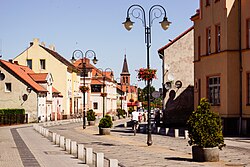world.wikisort.org - Poland
Pieńsk [pʲɛɲsk] (German: Penzig) is a town in Zgorzelec County, Lower Silesian Voivodeship, in south-western Poland. It is the seat of the administrative district (gmina) called Gmina Pieńsk, and stands on the east bank of the Lusatian Neisse river, which forms the border between Poland and Germany.
Pieńsk | |
|---|---|
 Main promenade in Pieńsk | |
 Flag  Coat of arms | |
 Pieńsk  Pieńsk | |
| Coordinates: 51°14′47″N 15°2′46″E | |
| Country | |
| Voivodeship | |
| County | Zgorzelec |
| Gmina | Pieńsk |
| First mentioned | 965 |
| Town rights | 1962 |
| Government | |
| • Mayor | Tadeusz Łowicki |
| Area | |
| • Total | 9.92 km2 (3.83 sq mi) |
| Population (2019-06-30[1]) | |
| • Total | 5,828 |
| • Density | 590/km2 (1,500/sq mi) |
| Time zone | UTC+1 (CET) |
| • Summer (DST) | UTC+2 (CEST) |
| Postal code | 59-930 |
| Car plates | DZG |
| Climate | Cfb |
| Website | http://www.piensk.com.pl |
The town lies approximately 11 kilometres (7 mi) north of Zgorzelec, and 140 kilometres (87 mi) west of the regional capital Wrocław. As of 2019[update], it has a population of 5,828. Historically considered as part of Upper Lusatia, although more closely associated with Lower Silesia in the early 14th century and from 1815.
History

In the Early Middle Ages, Pieńsk was a stronghold of the Bieżuńczanie tribe,[2] one of the Polish tribes.[3] The oldest known mention of the settlement dates back to 965.[4] Its name is of Slavic origin, and comes from the word pień, which means "trunk".[4] It was included in the early Polish state by first Polish King Bolesław I the Brave and in the 11th century it passed to the Duchy of Bohemia, which was elevated to a kingdom in 1198. The Upper Lusatian lords of Penzig (von Penzig) are first recorded in 1241. Besides Pieńsk the family held a number of other towns and territories on both banks of the Lusatian Neisse river. In 1250 a castle was built.[4] In 1321 local Polish Duke Henry I of Jawor confirmed the rights of the Penzig family to the settlement.[5] From the 14th century until 1815 at various times Pieńsk was under the rule of local Polish dukes of the Piast dynasty,[4] kings of Bohemia, Hungary, electors of Saxony and kings of Poland. In 1491 the city of Görlitz purchased the Penziger Heide (parts of the territory of Penzig) and combined it as Görlitzer Heide with its own communal territory.
In 1815 it was annexed by Prussia, and, subsequently, in 1871 it became part of Germany. In 1841 it suffered a fire.[4] During World War II, there was a military hospital in the village, in which initially Polish, and later also French and Yugoslavian prisoners of war were kept.[6] The first 493 wounded Polish prisoners of war arrived to the hospital on September 22, 1939, during the joint German-Soviet invasion of Poland, which started the war.[6] Meetings of Polish prisoners of war, joint singing and Polish church services took place in the hospital.[6] Overall, 42 Polish prisoners of war died in the hospital,[4] and the bodies of the deceased were burned on the spot and buried at the local cemetery.[6] There is a monument dedicated to them at the cemetery.[4][6] The Germans also established the RAD-Lager 5/104 forced labour camp in the village. The Polish Second Army fought nearby on April 16–17, 1945, during the final stages of the war. After the defeat of Nazi Germany in 1945, Pieńsk became again part of Poland. In accordance to the Potsdam Agreement, the German population was expelled and the settlement was resettled by Poles, many of whom were displaced from former eastern Poland annexed by the Soviet Union.
In 1962 Pieńsk was granted town rights.[4] Since 1999 it is administratively part of the Lower Silesian Voivodeship.
Notable residents
- Minna Reichert (1869–1946), German politician
- Władysław Filipkowski (1892–1950), Polish military commander
- Gerd Tacke (1906–1997), German businessman
- Anna Zwirydowska (born 1986), Polish female freestyle wrestler
References
- "Population. Size and structure and vital statistics in Poland by territorial division in 2019. As of 30th June". stat.gov.pl. Statistics Poland. 2019-10-15. Retrieved 2020-02-14.
- Bena, Waldemar (2006). Szlakiem grodzisk słowiańskich i średniowiecznych zamków (in Polish and German). Zgorzelec. pp. 9–10.
- "Plemiona polskie". Encyklopedia Internautica (in Polish). Retrieved 27 December 2020.
- "Historia". Gmina Pieńsk (in Polish). Retrieved 13 February 2020.
- Hermann Knothe, Geschichte des Oberlausitzer Adels und seiner Güter, Breitkopf & Härtel, Leizpig, 1879, p. 568 (in German)
- Lusek, Joanna; Goetze, Albrecht (2011). "Stalag VIII A Görlitz. Historia – teraźniejszość – przyszłość". Łambinowicki rocznik muzealny (in Polish). Opole. 34: 29.
External links
- Herren von Penzig territory purchased by city of Görlitz
- Penziger Heide and Görlitz on both banks of Neiße River on 1645 map.
- Historical Map of Lausitz, Görlitzer Kreis, Pentzig. East of Neiße River.
- Official town website
- Pieńsk information service
На других языках
[de] Pieńsk
Pieńsk [.mw-parser-output .IPA a{text-decoration:none}'pʲɛɲsk] (deutsch Penzig, obersorbisch Pjeńsk) ist eine Stadt mit etwa 6000 Einwohnern im Südwesten Polens. Sie liegt 13 km nördlich von Görlitz östlich der Lausitzer Neiße und gehört dem Powiat Zgorzelecki in der Woiwodschaft Niederschlesien an. Die Stadt ist Mitglied der Euroregion Neiße und bildet mit den umliegenden Ortschaften eine Stadt- und Landgemeinde.- [en] Pieńsk
[ru] Пеньск
Пеньск (польск. Pieńsk), Пенциг (нем. Penzig) — город в Польше, входит в Нижнесилезское воеводство, Згожелецкий повят. Имеет статус городско-сельской гмины. Занимает площадь 9,9 км². Население 6036 человек (на 2007 год).Другой контент может иметь иную лицензию. Перед использованием материалов сайта WikiSort.org внимательно изучите правила лицензирования конкретных элементов наполнения сайта.
WikiSort.org - проект по пересортировке и дополнению контента Википедии
